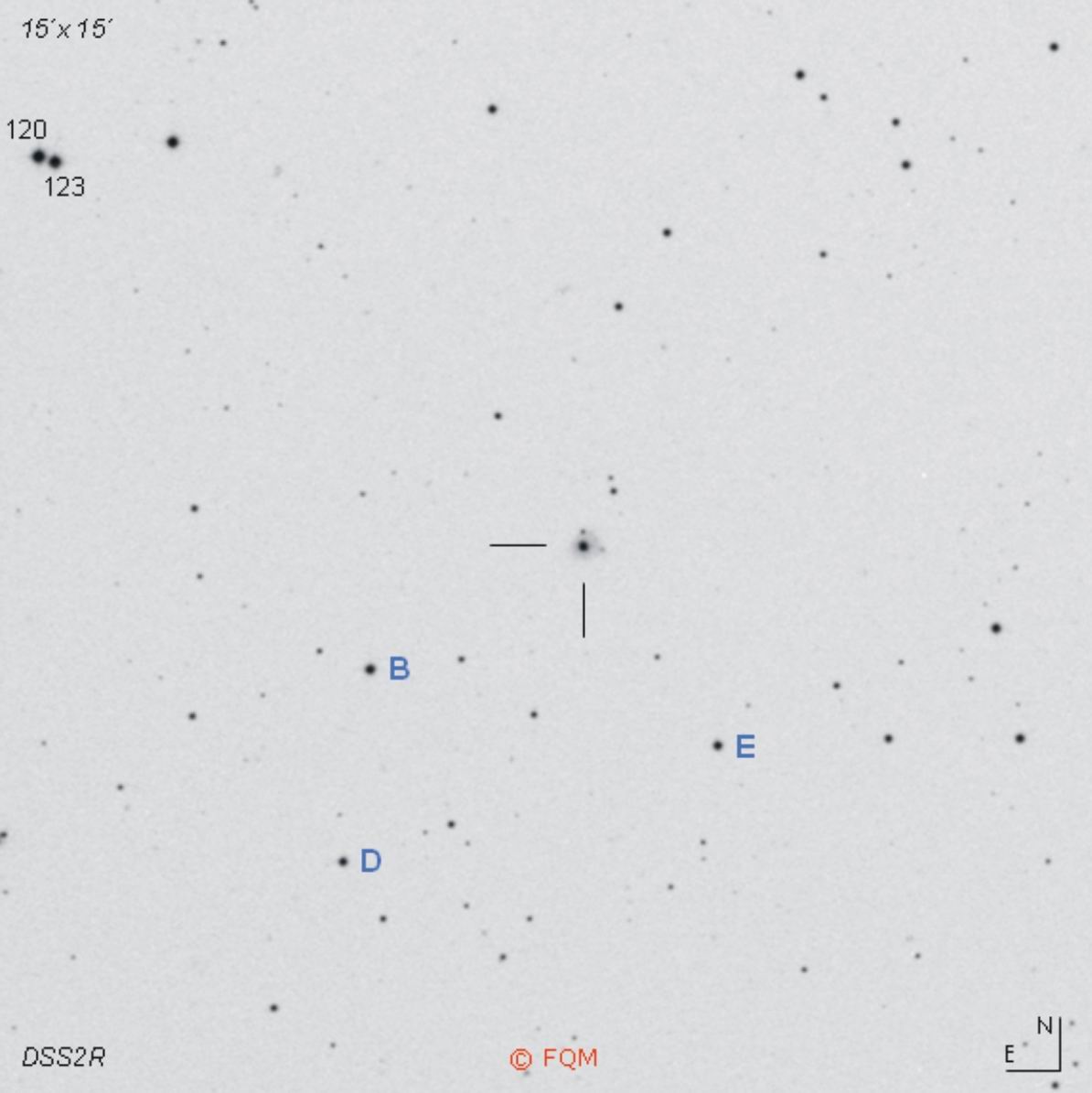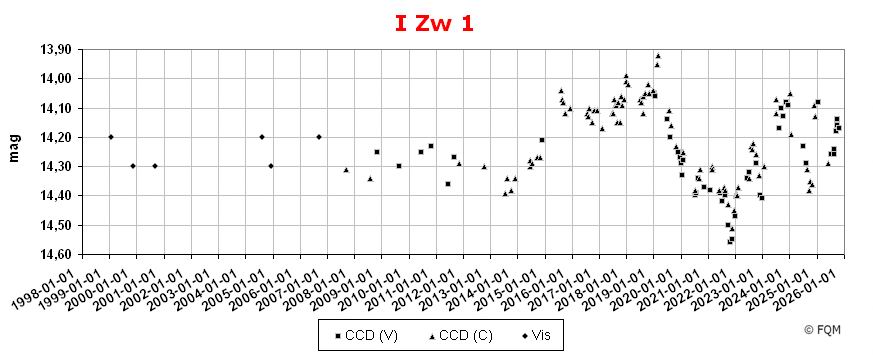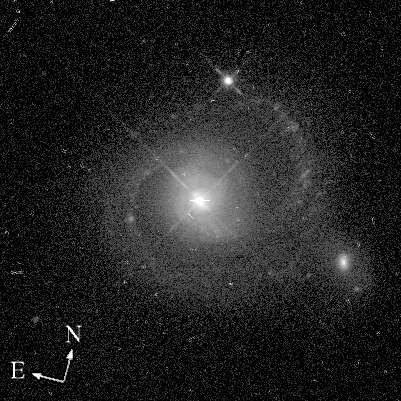
| Frankfurt Quasar Monitoring |
| I Zw 1 |
| Cross-Identifications | Z0051+12, PHL 3072, MRK 1502, UGC 545, PGC 3151 1ES 0050+124, RX J0053.5+1241, IRAS 00509+1225 2MASSi J0053349+124135, NVSS J005334+124133 1AXG J005334+1241, 2E 0050.9+1225, 0050+124 2XMM J005334.9+124136, 1WGA J0053.5+1241 QSO B0050+124, 1 Zw 0051+12, PG 0050+124 |
| Equat. coordinates | RA 00 53 34.9 DE +12 41 36 (J2000) |
| Constellation | Pisces |
| Type (1) | QSO |
| Redshift (1) | z=0.061 |
| Distance (2) (3) | 234 Mpc |
| Total mag range (mv) (4) | 13.89 - 14.51 |
| Catalog Magnitude (1) | 14.03 |
| Absolute Magnitude (1) | -23.4 MB |
| Light Travel-Time (2) | 0.744 × 109 yrs |

Comparison stars
| star | B | V |
| B | 14.42 | 13.72 |
| D | 15.02 | 14.40 |
| E | 15.78 | 14.56 |


| Quasar
I Zw 1 is located in the central part of Pisces, about 1.7° NE of 5.5-mag
star
58 Psc. The
designation I:Zw:1 refers to swiss-born
astronomer Fritz Zwicky (Zw)
who recognized this object as a compact galaxy
("variable blue spherical, very compact, with a patchy halo“) and
listed it in his first catalog in 1964. The
spectrum of I Zw 1 was classified a type Seyfert 1, with
exceptionally "narrow“ emission
lines (NLS1). Due to its high absolute magnitude of -23.2 MB (given at that time), this compact Seyfert galaxy was classified as a quasar. Considering its high optical luminosity and the small cosmological distance, I:Zw:1 is often claimed "the nearest QSO". I Zw 1 is a face-on spiral galaxy that harbours an AGN at its centre. The host galaxy has two asymmetric spiral arms, both of which show knots of star formation (see image above). The galaxy disk spans 30 kpc in diameter. Furthermore, I Zw 1 is undergoing a strong phase of starburst in a ring-like area around the centre. From there most of the emitted radiation is produced. As a result, most of the total (near-) nuclear light is emitted in the blue- and ultraviolet-part of the spectrum (PG, PHL, MRK). Therefore, the most remarkable property of I Zw 1 is the optical emission composite starburst/AGN nature. The starburst/AGN activity is obviously triggered by an interacting fainter companion galaxy close to the west (see image above). In the POSS-image above, I Zw 1 appears as an extended object with a photographic diameter of 30". The filamentary structure is very obvious and represents the spiral arm pattern of the quasar host galaxy. The point source just north of the galaxy disk is a foreground star. Visually, observers need at least a telescope of 8- to 10-inch of aperture to detect I Zw 1 as a faint stellar object of about mag 14.0-14.4. Through larger apertures, observers may recognize hints of the quasar host: The stellar appearance increasingly changes and becomes more extended and diffuse, with a star-like nucleus. CCD observers, as well as visual observers, shall use the comparison stars given above. Another photometric sequence was published by Gonzŕlez-Pérez et al. (2001). ____________
The close vicinity around quasar I Zw
1 is
void of bright deep sky objects. However, by enlarging the radius to about 10°,
observers find some beautiful highlights that shall
not be missed. M 74: Stop down for famous M 74, a bright face-on spiral galaxy, about 11° E of I Zw 1. M 74 is located NGC 488: Heading 10° SE from I Zw 1, you find 11-mag galaxy NGC 488, a pretty bright Sb-spiral with “delicate spiral pattern“.
NGC 470 galaxy group: About 2° S of NGC 488 you reach the NGC 470 galaxy
group. The group consists
of at least 3 galaxies
and is dominated by
NGC 474, a giant elliptical, that shows an interesting shell structure
due to
interactions with neighbouring NGC 470 (Arp 227).
IC 1613: ...is a large and faint irregular galaxy, which is
a member of the local group; located 11° S.Observers who like to hunt down some more very old quasi-stellar photons may turn to BL Lac object S2 0109+22, a variable 15-mag object at a distance of nearly 3×109 light-years, 11° NE of I Zw 1. |
| Crenshaw, D.M., Kraemer, S.B., Gabel, J.R. 2003, AJ, 126, 1690; The Host Galaxies of Narrow-Line Seyfert 1 Galaxies: Evidence for bar-driven Fueling. Halpern, J.P., Oke, J.B. 1987, ApJ, 312, 91; Narrow-Line Seyfert Galaxies with permitted FE II Emission: Markarian 507, 5C 3.100 and I ZW 1. Hansen, T. 1991, Deep Sky Magazine 34, 32; The “Deepest” Deep Sky Objects. Hutchings, J.B., Crampton, D. 1990, AJ, 99, 37; Images and off-nuclear spectroscopy of QSOs. Karge, S.; Helle Quasare für 8- bis 10-Zoll Teleskope. Ein Beobachtungsführer zur visuellen Beobachtung von Quasaren und BL Lacertae Objekten; Frankfurt 2005. Osterbrock, D.E. 1977, ApJ, 215, 733; Spectrophotometry of Seyfert 1 galaxies. Penston, M.J., et al. 1971, PASP, 83, 783; Stars observed photoelectrically near quasars and related objects. Sargent, W.L.W. 1968, AJ, 73, 893; New observations of compact galaxies. Sargent, W.L.W. 1970, ApJ, 160, 405; A Spectroscopic Survey of Compact and Peculiar Galaxies. Schinnerer, E., Eckart, A., Tacconi, L.J. 1998, ApJ, 500, 147; Molecular Gas and Star Formation in the Host Galaxy of the QSO I ZW 1. Schmidt, M., Green, R.F. 1983, ApJ, 269, 352; Quasar evolution derived from the Palomar Bright Quasar Survey and other complete quasar surveys. Steinicke, W. 1998, Interstellarum 14, 24; Im Quasar-Fieber. Steinicke, W.; Katalog heller Quasare und BL Lacertae Objekte; Umkirch 1998. Steinicke, W.; Beobachtungsliste für helle Quasare; Umkirch 1999. Véron-Cetty, M.-P., Véron, P. 2001, A&A 374, 92; A Catalogue of Quasars and Active Nuclei: 10th edition. Véron-Cetty, M.-P., Véron, P. 2003, A&A 412, 399; A Catalogue of Quasars and Active Nuclei: 11th edition. Véron-Cetty, M.-P., Véron, P. 2006, A&A 455, 776; A Catalogue of Quasars and Active Nuclei: 12th edition. Véron-Cetty, M.-P., Véron, P. 2010, A&A 518, 10; A Catalogue of Quasars and Active Nuclei: 13th edition. Zwicky F., et al. 1960-1968; Catalogue of Galaxies and of Clusters of Galaxies; Vol. 1-6, California Institute of Technology. |
| Links: I Zw 1 (Sasmirala, Univ. of Heidelberg) Chara/PEGA |
| home |